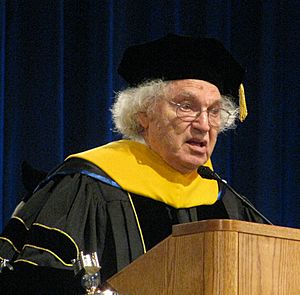Herbert Hauptman facts for kids
Quick facts for kids
Herbert Hauptman
|
|
|---|---|

Hebert A. Hauptman in 2009
|
|
| Born |
Herbert Aaron Hauptman
February 14, 1917 |
| Died | October 23, 2011 (aged 94) |
| Nationality | American |
| Alma mater | University of Maryland, College Park |
| Awards | Nobel Prize in Chemistry (1985) (jointly with Jerome Karle) |
| Scientific career | |
| Fields | Mathematician |
| Institutions | Hauptman-Woodward Medical Research Institute & University at Buffalo |
Herbert Aaron Hauptman (born February 14, 1917 – died October 23, 2011) was an American mathematician. He won a Nobel Prize for his work in chemistry. He created a special mathematical way to figure out how atoms are arranged in tiny crystals using X-ray patterns. He shared the 1985 Nobel Prize in Chemistry with Jerome Karle.
Early Life and Education
Herbert Hauptman was born in New York City. He was the first child of Israel Hauptman and Leah Rosenfeld. From a young age, he was very interested in science and mathematics.
He went to Townsend Harris High School. Later, he graduated from the City College of New York in 1937. He then earned a master's degree in mathematics from Columbia University in 1939. On November 10, 1940, he married Edith Citrynell, and they had two daughters.
Solving Molecular Puzzles
After World War II, Herbert Hauptman started working with Jerome Karle. Karle was a physical chemist. They worked together at the United States Naval Research Laboratory in Washington, D.C.. At the same time, Hauptman was also studying for his Ph.D. at the University of Maryland, College Park.
They combined their skills in mathematics and physical chemistry. Their goal was to solve a big puzzle in science called the "phase problem" of X-ray crystallography. This problem was about how to figure out the exact shape of molecules using X-rays.
By 1955, Hauptman had earned his Ph.D. in mathematics. Together, he and Karle had developed "direct methods" in X-ray crystallography. This was a new mathematical way to solve the phase problem. Their important article from 1953, called "Solution of the Phase Problem I. The Centrosymmetric Crystal," introduced their main ideas. The most important idea was using probability to help solve the puzzle.
Later Career and Nobel Prize
In 1970, Herbert Hauptman joined the Medical Foundation of Buffalo. He became its Research Director in 1972. During this time, he continued to develop his theories. He worked on ideas like the "neighborhood principle" and the "extension concept." These theories helped make the direct methods even better.
His work with Jerome Karle made it much easier for scientists to discover the structures of molecules. This was very important for chemistry and medicine. For their groundbreaking work, they were awarded the 1985 Nobel Prize in Chemistry.
See also
 In Spanish: Herbert A. Hauptman para niños
In Spanish: Herbert A. Hauptman para niños

